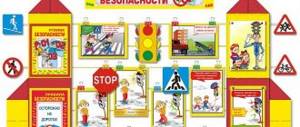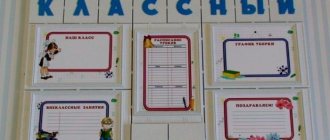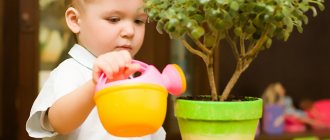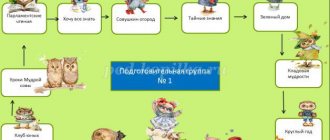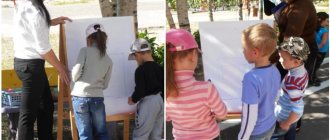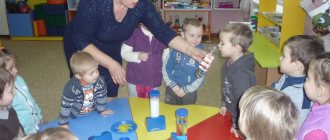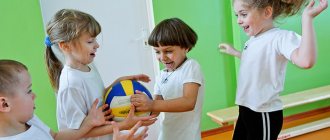According to the existing requirements for the organization of a developmental environment in educational institutions, it is necessary to create comfortable conditions in preschool educational institutions not only for active activities of pupils, joint games, classes under the guidance of a teacher, but also for psychological relief and recreation for children. When spending the whole day in a noisy group, a child may need personal space. For this purpose, a “Privacy Corner” is placed in the kindergarten. What such a zone is, how to make it with your own hands and what items to fill it with, we will tell you in this article.
The purpose of the “Privacy Corner” in kindergarten
Preschool children often change their mood due to insufficient development of the emotional-volitional sphere. Children do not yet know how to control the manifestations of their feelings. Therefore, there is often a demonstration of such emotional manifestations as anger, rage, and sadness. For a child, changing the environment, staying all day in a noisy circle of people in the absence of his mother, as well as fulfilling the requirements of teachers and accepting a large amount of new information is serious stress. Therefore, to maintain the psychological comfort of a preschooler, special areas are created in groups where the child can be alone. In such a corner, the baby can “hide” from others, express his accumulated negative emotions, distract himself from the hustle and bustle with the help of interesting, quiet games and simply relax in silence.
Thus, the “Privacy Corner” in kindergarten helps solve the following psychological and pedagogical problems:
- create conditions for the development of the emotional sphere of a preschooler;
- help children adapt to new conditions, peers, teachers;
- create a positive microclimate in the children's team;
- prevent nervous overstrain of pupils, reduce the likelihood of conflict situations.
What is a corner of solitude
Picture 2 A place of solitude helps reduce stress
A privacy corner is a specially designated part of the room where a relaxation area for children is set up. It is understood that the presence of such a separate zone in each group of a preschool educational institution (DOU) helps children of all ages:
Everyone needs a corner of privacy
- Adapt to kindergarten.
- Experience temporary separation from parents.
- Overcome the stress that inevitably arises when communicating with peers.
- Get used to and get used to new people and circumstances around you.
Goals and objectives
Creating such a relaxation zone is necessary to solve the following problems:
- To help preschool children survive separation from their parents, to facilitate adaptation to new conditions and the requirements of kindergarten. To do this, soft objects and toys familiar to children are placed in the corner of solitude, causing positive feelings and helping children relax and unwind.
- Teach your child to express negative emotions: anger, resentment, malice in a form that is safe for a fragile psyche. For these purposes, a corner can be decorated with an area with soft objects for hitting or hugging, boxes or jars in which the child hides his negative emotions.
- Help children learn to manage their emotional state and gain self-confidence. For this purpose, there is a board or sheet of paper on which preschoolers depict their mood, various objects illustrating emotions: joy, sadness, anger, fear.
- Increase the self-esteem of shy and timid children.
- teach preschoolers to resolve conflicts that arise when communicating with peers, to make peace after disputes and quarrels. An island of reconciliation corresponds to these goals - a special rug or fenced-in area where children must resolve their differences.
The teacher himself can ask the child to go to the privacy zone if he sees that he cannot cope with his emotional state (excessive aggression towards other children, prolonged worries about separation from parents, a pronounced reluctance to contact other children, severe shyness). Most often this happens in the younger groups of kindergarten.
Subsequently, in the middle and older groups, children already have a clear idea of the goals of this relaxation zone and independently make the choice to retire there if they think that they need it.
Note! It is important to remember that a child of any age is a person, the only difference being that at this stage of his development he has less life experience than an adult. And any manifestation of children's negative emotions should be perceived calmly and with understanding - the baby simply does not know how to do it correctly and does not yet foresee all the consequences of his actions.
Lesson on FEMP and parental consultations in preparatory groups
The relevance of overcoming the negative emotional state of a child
Ensuring the emotional well-being of children in preschool educational institutions is a condition put forward in the first place by the federal state educational standard (FSES). Accordingly, the main task of preschool institutions is to ensure the emotional comfort of their students.
Stress needs to be removed
But even without state regulations, standards and presentations, it is obvious that a positive emotional state and a positive attitude of a child are necessary for the harmonious development of the individual. Children, as the least psychologically protected category of society, require a special approach to their emotional needs.
Note! Negative emotions are a necessary and inevitable experience, and teaching children to perceive them correctly, offering them ways to experience them correctly is one of the main goals of education.
It is to solve this problem that in the last 10-15 years, corners of solitude have begun to appear in kindergartens, in which children can throw out their negativity without putting their peers at risk.
Recommendations for design
In a kindergarten, the “Privacy Corner” should be a closed, comfortable space. The child needs to feel safe and confident that no one will disturb him in this area. Therefore, most often such a corner is designed in the form of a hut, tent, house.
It is important to create an atmosphere of home comfort and tranquility. Therefore, it is recommended that the interior of the space should have dim lighting, a lot of pillows, a soft comfortable sofa, paintings and other little things that will help realize the idea.
Of course, it is necessary to take care of the safety of children. So, under no circumstances should small, sharp or breakable objects, paints or other chemicals be placed in the corner. A “window” should be provided in advance so that in some cases the teacher, without disturbing the child or violating his personal space, can make sure of his safety and well-being.
How to make a “Privacy Corner” in kindergarten? The design depends on the interior of the group, as well as the preferences of the children themselves. Pupils can take a direct part in the production and decoration of such an area.
How to make a corner of privacy with your own hands
The Federal State Educational Standards standards impose certain requirements on the corner of solitude:
- The size of the corner of privacy should not be too large, since a feeling of peace and comfort for children is created by small shelters: houses, tents, tents.
- The color scheme of the privacy corner should be dim, the light dim, since the purpose of this place is to calm, pacify, and relax.
- There should be a rug or soft bedding and pillows on the floor.
- The items that fill the corner of solitude should be of a developmental nature, encouraging children to be creative and self-improvement.
- In a corner of solitude, to create a feeling of stability, a certain part of the objects should remain unchanged; the presence of the rest can be periodic, fueling preschoolers’ interest in this place.
- When creating a relaxation zone, educators should take into account the age of their charges. Toys must meet aesthetic and hygiene requirements.
- Safety requirements must be observed: no sharp or breakable objects.
Note! In the corner of privacy, you can make a window that allows you to periodically observe the child to make sure he is safe and well. However, it should not violate the baby’s personal space.
Ideas for decorating a corner
When creating the design of a corner of solitude, the teacher should focus on the age of his charges. For the younger group of preschool educational institutions, it is relevant to design a space with a low, narrow entrance. The child will feel comfortable and safe in such an environment.
Classes on cognitive development in older groups
For other age groups, larger spaces such as a tent or house are suitable, the entrance to which can be curtained with a piece of fabric or covered with a screen. Instead of toys, in such an area you can place items exclusively for educational games or other activities:
- Games for developing emotionality (ready-made or homemade).
- Magical items that transform negative emotions into positive ones.
- Soft objects for hugging or hitting, depending on the surging emotions.
- Visual activity - draw your mood at the moment, or what mood the child wants to experience in the future.
- physical activity - various calming exercises or objects to improve fine motor skills.
Soft toys will come in handy
There can be several options for creating frames for tents:
- The most cost-effective option: fence off a corner of the common room with a screen or curtain. They can be decorated with flowers, stars, butterflies, and birds cut out of paper.
- The most convenient and original option for a tent is a large umbrella. It should be turned over and hung by the handle from the ceiling, which also does not require serious investments. A piece of fabric or a curtain of ribbons is attached to the umbrella.
- If there is not enough space in the room to accommodate a privacy zone, then you can use a screen as a fence. The location of such a zone can be changed at will;
- The simplest frame of the house in terms of execution is the version made of plastic pipes. The configuration of such a frame can also be made with your own hands and changed at will without any special financial or time costs.
A corner of privacy in a kindergarten made of plastic pipes
The use of ordinary plumbing plastic pipes to create a privacy zone in a kindergarten allows you to create many configurations: from locks to rockets. Everything is limited only by the designer’s own imagination. Using fabric or ribbons as drapery, you can give these plastic structures different looks.
The option made from PVC pipes will be budget-friendly
The big advantage for such structures is the ease of their installation and the mobility of the manufactured structures.
The transition from a family where the child was surrounded by his closest and dearest to a group of complete strangers is probably the first most severe shock for a child. Do not underestimate its effect on a fragile nervous system. Each child experiences this type of stress differently. The main task of an adult is to teach a child not to hide his emotions within himself, but to express them in such a way as not to harm himself or others who find themselves in a similar situation. And corners of solitude in kindergartens help solve this problem.
Design ideas
You can make a “solitude corner” in a kindergarten with your own hands, for example, in the form of a “fairytale tent”, “gnome’s house”, “magic cave”, “sunny room”.
We offer simple and affordable ways to make such a play area:
- Separate off one corner of the group room with a curtain attached to the cornice. If desired, you can decorate the fabric, for example, with stars, flowers, smiley faces.
- You can make a corner from a factory children's tent. An appropriate size mattress and plenty of decorative pillows should be placed on the floor.
- You can build a full structure. So, the frame is made of plastic pipes. Then it is covered with fabric and decorated with trim.
Depending on the preferences of the children in the group, you can create a comfortable themed “Privacy Corner” in the kindergarten. The photo below shows the personal space area in the form of a “princess tent”.
Games to improve your mood
“Having let off steam,” the baby needs to calm down and recharge with positive energy. Therefore, the central place in such an area is occupied by a comfortable sofa with pillows. Nearby you can place a small table for board games. In addition, in kindergarten, the “Privacy Corner” may contain the following items:
- sensory pads and other fine motor games (e.g. sorters, insert games, cereal boxes, kinetic sand, massage balls);
- photo albums;
- materials for development and creativity (pencils, markers, paper, books);
- “box of wishes” for children’s drawings;
- dolls with which the baby can share his “secrets”;
- toy phone for “calling mom.”
It is recommended that soothing music (sounds of nature) be played in such an area.
Didactic games
General developmental materials are aimed at distracting the child from negative thoughts. You can suggest placing the following didactic games in such a recreation area:
- “Who’s in what mood?”
- “Complete the smiley face.”
- "Put the puzzle together."
- “Our emotions” and others.
Favorite books will also help your child cope with a bad mood.
Materials in the recreation area should be updated regularly. But it is recommended to leave the basic elements unchanged so that the baby feels comfortable in a familiar environment.
We shared ideas on how to create a “Privacy Corner” in kindergarten. But we note that there are no strict recommendations here - the teacher needs to listen to his students, their wishes, preferences and create a completely unique zone of comfort, psychological safety and good mood.
"Center for solitude and relaxation"
“Center for solitude and relaxation as a means of emotional comfort for a preschooler”
Author:
Skvortsova Natalia Alexandrovna
Educator
MDOU No. 5 "Rainbow"
Tutaev
Relevance
In a kindergarten group, a child is in a group all day, regardless of his mood and experiences. Sometimes he gets tired of communicating with his peers, from games, from the environment, and sometimes he can show negative emotions: anger, malice, aggression, resentment. The behavior and mood of a child greatly depends on his emotional state. Therefore, the problem of the child’s emotional well-being becomes of great importance.
One of the tasks that the Federal State Educational Standard is aimed at is protecting and strengthening the mental health of children, including their emotional well-being.
There is a time when you want to be alone with your thoughts, experiences, mood, you want to relax. The child also has the right to this.
The development of a subject-spatial environment in accordance with the Federal State Educational Standard pays attention not only to ensuring joint activities of children and adults, physical activity of children, but also opportunities for their privacy.
Therefore, to solve this problem of combating negative emotions in children, I created the “Center for Solitude and Relaxation” in the group.
Target:
creation of personal space for the formation of the child’s emotional well-being.
Tasks:
- Expand the possibility of personal space in the group;
- Create an atmosphere of psychological comfort;
- Create conditions for mastering self-regulation techniques in children;
- Create a positive microclimate in the children's team.
Organization of a “Center for Solitude and Relaxation” in a group room
Types of retreat centers:
• “Mink” (younger age)
• “Tent” (middle, older age)
• “Screen” (used at any age, used where space does not allow)
Our center fits harmoniously into the group space. For decoration I used translucent fabrics; the principle of semi-openness was also used; if necessary, it can be closed.
The contents of the corner are periodically updated, but some items are constantly present, this gives children a sense of confidence and permanence.
Interaction between teacher and children
The teacher observes what the child does there, how much time he spends there and how often. The “Center for Solitude and Relaxation” may have a diagnostic and monitoring function.
The effectiveness of the work depends on how aware the children are of the purpose of the center, its equipment and ability to use the attributes. As new attributes are added, children are shown various types of activities with them.
Operation
"Center for Solitude and Relaxation"
The panel “Mood” depicts a mansion; when opening the doors of the mansion, the child improves fine motor skills (doors with zippers, buttons, cords, etc.) and sees emoticons with various emotions in transparent pockets, which he can distribute at his discretion in any house. Pictures in the houses can change, for example, emotions of boys, girls, funny, sad animals, postcards, etc. (This panel has one more function - it covers the screen with the battery).
Mirror of my mood. If a child is in a bad mood, he looks at himself in the mirror and smiles. Your mood will definitely improve.
Little heart. In the event of a conflict situation, quarrel or fight, they take the heart, stick their hands in and, with the help of the peace box, resolve their conflict.
“Hugging pillow” for relieving stress (with small balls), which you can press to yourself and move the small balls with your fingers, which also calms you down.
Didactic games (laces, beads, good-bad game, guess the emotion).
“Mood masks” that children can try on.
“Magic balls” B, in which there are balls of thread. This bunny comes to the rescue when children are angry, you can offer them to rewind the threads.
“Family Album” In the center of solitude, it is necessary to use those objects that are close to the child and give him a feeling of confidence. This could be an album with family photos.
We also placed a toy phone on which you can call mom or dad, grandma, etc.
Benefits for releasing negative emotions.
“Glass for anger” When aggression occurs, you can invite the child to leave all bad words and mood in this glass, then the glass is closed and hidden.
Rug of Anger An ordinary rug with a rough surface. A child without shoes wipes his feet until he wants to smile.
Development prospects
In the future, I plan to place a “Good Deeds” box, which will stimulate the desire in children to “do good.”
Conclusion:
A properly organized subject-development environment (Center for Solitude and Relaxation) will help children to be distracted and forget negative emotions and experiences, will help them understand the whole range of feelings that they experience, learn to evaluate actions, learn to interact with the teacher and peers, and this is precisely what lies at the basis of developmental education.
Literature:
— Belinskaya E.V. Fairytale trainings for preschoolers and primary schoolchildren, St. Petersburg: Speech; M.: Sfera, 2008. – 125 p.
— Danilina T.A., Zedgenidze V.Ya., Stepina N.M. In the world of children's emotions: A manual for practical workers of preschool educational institutions. – M.: Iris-press, 2004. – 160s – (Library of educational psychologist)
Internet resources:
— https://www.maam.ru/detskijsad/sozdanie-psihologicheskogo-komforta-detei-v-detskom-sadu.html
— https://festival.1september.ru/articles/628133/
-https://kopilkaurokov.ru/doshkolnoeobrazovanie/presentacii/ugholok-uiedinieniia-kak-odno-iz-uslovii-vniedrieniie-fgos-do
